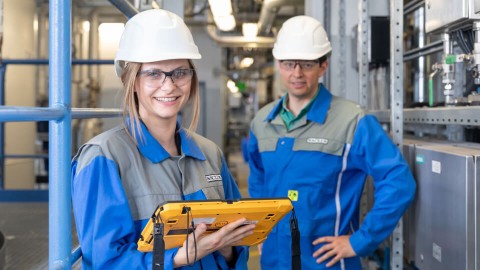VINNAPAS® EF 8001 (CTY)

VINNAPAS® EF 8001 (CTY) is an aqueous vinyl acetate-ethylene copolymer dispersion. It was developed as a higher performance alternative to vinyl acrylic copolymers with environmental advantages.
Properties
As a broad application binder for architectural coatings, VINNAPAS® EF 8001 (CTY) provides a variety of benefits for the coatings formulator:
- Industry benchmark for scrub resistance
- Low glass transition temperature (Tg)
- Low minimum film formation temperature (MFFT)
- Requires little to no coalescing solvent allowing for performance coatings at very low VOC levels
- Excellent thickener response with a number of different thickener types, including (HMHEC, HEUR and HASE)
- Produced without the use of APEOs
- Manufactured without the use of any formaldehyde donors
Data sheets
VINNAPAS® EF 8001 (CTY) represents the next in a line of VAE copolymer dispersions that is positioned to broadly replace vinyl acrylics in the architectural coatings industry. It has application in contractor and Do-it-Yourself (DIY) products and is recommended for flat through mid-sheen finishes. With the environmentally friendly design of VINNAPAS® EF 8001 (CTY), it is compliant with any major “green” requirements foreseeable in the coatings industry.
VINNAPAS® EF 8001 (CTY) is also very compatible with other latex dispersions and can be blended with other polymers such as high Tgpure acrylics to provide improved block resistance and wet adhesion, properties which are necessary in higher end and higher gloss/sheen coatings.
VINNAPAS® EF 8001 (CTY) has been designed for both interior and exterior formulations, either as a sole binder or in blends with other vehicles, such as acrylics. Exterior paints based on VINNAPAS® EF 8001 (CTY) have been exposed in multiple climates on a variety of substrates. Performance over dimensionally unstable wood substrates has shown comparable grain-cracking resistance to vinyl acrylics. In addition, over "hot masonry" substrates, VINNAPAS® EF 8001 (CTY) exhibits significantly better resistance to alkaline hydrolysis versus conventional vinyl acrylic polymers.
VINNAPAS® EF 8001 (CTY) continues the standard for scrub resistance set by VAE copolymers as evidenced by evaluations of several different formulations that show it outperforming both conventional and low VOC latexes. This allows paint formulators to develop paints with extremely high levels of scrub resistance.
A key requirement for contractor flat paints involves the property of touch-up, which is characterized as maintaining a visually uniform appearance of a film surface upon repainting after the initial coat of paint has been applied. While the choice of pigments used in the formulation can also have a significant effect on this property, the choice of polymer has a major impact on low temperature touch-up, particularly in lower VOC systems. VINNAPAS® EF 8001 (CTY) exhibits excellent ambient and low temperature touch-up properties in general, which is characteristic of many VAE polymers.
VINNAPAS® EF 8001 (CTY) exhibits excellent thickener response with a number of different thickener types, including hydrophobically modified cellulosics (HMHEC), hydrophobic ethoxylated urethanes (HEUR), and hydrophobic alkali-swellable emulsions (HASE).
With the ever-tightening restrictions on the permissible level of VOCs in coatings, it is becoming more important that the polymers used in formulations can be formulated at lower solvent levels without sacrificing performance. Many commercial binders used today, especially conventional vinyl acrylics, suffer significantly in performance when formulated at lower solvent levels. VINNAPAS® EF 8001 (CTY) requires little to no coalescing solvent, which allows formulators to develop high performance coatings even at low VOC paints. The reduction in solvent provided by formulating with VINNAPAS® EF 8001 (CTY) compared with conventional vinyl acrylics can deliver additional raw material cost savings.
Specific formulating tips are available upon request and in the future will be available in the Formulation Guidelines bulletin on the WACKER web site.
If the product is used in applications other than those mentioned, the choice, processing and use of the product is the sole responsibility of the purchaser. All legal and other regulations must be complied with.
For questions concerning food contact status according the chapter 21 CFR (US FDA) and German BfR, please feel free to contact us.
Wacker Chemie AGGisela-Stein-Strasse 1
81671 Munich
Germany
Storage
When the dispersion is stored in tanks, proper storage conditions must be maintained. If stored in the original, unopened containers at cool (below 30 °C), but frost-free temperatures the product has a shelf life of 9 months from the date of manufacture. Any longer periods for the maximum storage period that may be described in the Certificate of Analysis which accompanies each shipment of the product, take preference over this suggestion in which case the time period stated in the Certificate of Analysis shall be solely authoritative. Iron or galvanized-iron equipment and containers are not recommended because the dispersion is slightly acidic. Corrosion may result in discoloration of the dispersion or its blends when further processed. Therefore, the use of containers and equipment made of ceramics, rubberized or enameled materials, appropriately finished stainless steel, or plastic (e.g. rigid PVC, polyethylene or polyester resin) is recommended. As polymer dispersions may tend to superficial film formation, skins or lumps may form during storage or transportation. Filtration is therefore recommended prior to utilization of the product.
Preservation for Transport, Storage and further Processing
The product is adequately preserved during transportation and storage if kept in the original, unopened containers. However, if it is transferred to storage tanks, the dispersion should be protected against microbial attack by adding a suitable preservative package. To maintain proper storage conditions appropriate measures should also be taken to ensure cleanliness of the tanks and pipes. In a storage tank in which the product is not stirred, it is advisable to contact your biocide representative/supplier. Proper procedures must be set up in order to prevent microbial attack between necessary periodic tank cleaning and sanitization. These procedures will vary, since loading and unloading practices in each storage situation will differ slightly. Finished products manufactured from polymer dispersions usually also require preservation. The type and scope of preservation will depend on the raw materials used and the anticipated sources of contamination. The compatibility with other components and the efficacy of the preservative should always be tested in the respective formulation. Preservative manufacturers will be able to advise you about the type and dosage of preservative required.
Sales and support
Allentown, PA 18106-9346
United States
+1 517 264-4088 (Fax)
How can we help you?
- Do you need help in choosing a product or do you require technical support? If so, please contact our experts.


